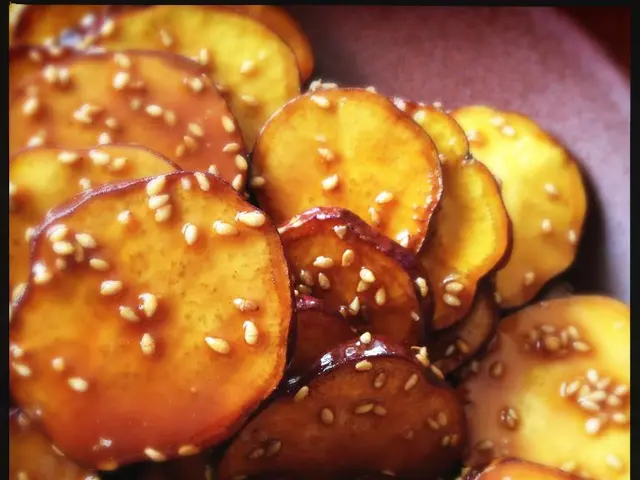Article Rewrite
Trump government to unveil strategy for eliminating synthetic food colorants from American food market
The Trump administration is flexing muscles to yank artificial food dyes from the nation's dinner tables, as hinted by a media burst from the U.S. Department of Health and Human Services on Monday.
A joint presser from Health Secretary Robert F. Kennedy Jr. and Food and Drug Administration (FDA) Commissioner Marty Makary is slated for Tuesday, where they'll spill the beans on the administration's dye-eliminating plans.
If you've been keeping tabs, you might recall a similar FDA announcement back in January, when they prohibited the use of red dye No. 3 in food, beverages, and medications. This decision followed nearly three decades of research linking red dye No. 3 to cancer in drooling lab animals[3].
The Trump administration looks all set to target a broader spectrum of synthetic, oil-based dyes used to color our sustenance, elevating its allure for consumers.
In a show of solidarity, Kennedy teamed up with West Virginia Governor Patrick Morrisey in March, supporting a legisation that'd ban selected synthetic dyes in grub. West Virginia became the first state to enforce such a sweeping ban on artificial dyes, which have been associated with learning difficulties and behavioral issues in select kids. Kennedy's been a vocal critic of these hyperactive hues[4].
More than half of the states, both democrat- and republican-led, are gunning for restrictions on artificial food dyes, reflecting a bi-partisan push towards a healthier food system[5]. The Trump administration's initiative might not be explicitly mentioned in the order forming the commission to "Make America Healthy Again," but some republican lawmakers have picked up Kennedy's "MAHA" motto in their proposals.
Industry associations have lobbied for a consistent federal standard instead of a patchwork of state regulations, with the National Confectioners Association claiming the FDA as the "rightful national regulatory decision maker" when it comes to food safety. Ironically, some of its member companies peddle products containing the very synthetic dyes they're calling for regulation[6].
John Hewitt, senior vice president of state affairs at the Consumer Brands Association, echoed the sentiment earlier this year, urging the FDA to take up its food safety mantle.
Critics have long flagged concerns about the health implications of artificial dyes. Red No. 3, red No. 40, blue No. 2, and green No. 3 have all been linked to cancer or tumors in rodents. Some sources claim red No. 40, yellow No. 5, and yellow No. 6 contain known carcinogens. Blue No. 1 and yellow No. 6 may also be toxic to human cells. A smidgen of yellow dye No. 5 can induce irritability, restlessness, and sleep problems in sensitive little ones[7].
Despite these concerns, experts have slammed the federal government's lackadaisical approach to funding research and regulating the dyes[8].
Prominent food policy researcher, Marion Nestle, voiced her approval, naming this as an easy victory. "It's about time these petroleum dyes got the boot. Non-petroleum substitute dyes are already in circulation globally, even among the same companies marketing their products stateside. Companies have been promising to drop the petroleum dyes for yonks. The time has indeed come," said Nestle[9].
Food dyes predominantly lurk in foods with little nutritional value, such as candy and soda[10]. But don't be fooled—these artificial additives might sneak into seemingly harmless products too. Expanding your awareness is key. Checking ingredient lists on food and beverage items can help you steer clear of synthetic dyes[11].
Contributions by CNN's Meg Tirrell
[1] https://www.hhs.gov/about/news/2025/04/20/us-department-of-health-and-human-services-to-announce-plans-to-eliminate-artificial-food-dyes.html[2] https://www.fda.gov/food/food-ingredients-packaging/food-dyes[3] https://www.fda.gov/news-events/press-announcements/fda-bans-use-red-dye-no-3-consumer-products[4] https://www.npr.org/sections/health-shots/2023/03/25/1048844349/robert-f-kennedy-jr-petroleum-dyes-west-virginia-legislation[5] https://www.ewg.org/foodnews/states-act-to-protect-consumers-from-fake-colors-in-food[6] https://www.cnbc.com/2023/03/25/fda- lifting-safety-uncertainty-over-artificial-food-dyes.html[7] https://www.cdc.gov/nceh/hsb/pubs/effects_of_food_dyes.htm[8] https://www.scientificamerican.com/article/the-toxicity-of-food-dyes/[9] https://www.nytimes.com/2025/04/19/health/food-dyes-are-bad-for-you-right.html[10] https://www.cspinet.org/new/pdf/FDCR-FactSheet.pdf[11] https://www.scientificamerican.com/article/a-tasting-for-fact-or-fiction-on-artificial-food-colors/
- The Trump administration aims to abolish artificial food dyes from American meals, as hinted by a statement from the U.S. Department of Health and Human Services.
- A joint press conference from Health Secretary Robert F. Kennedy Jr. and Food and Drug Administration (FDA) Commissioner Marty Makary is scheduled for Tuesday, where they will reveal the administration's plan to eliminate artificial food dyes.
- The FDA previously prohibited the use of red dye No. 3 in food, beverages, and medications in January, following nearly three decades of research linking the dye to cancer in laboratory animals.
- The Trump administration intends to target a broader scope of synthetic, oil-based dyes used to color our foods, potentially increasing their appeal for consumers.
- In a show of bipartisan support, Kennedy collaborated with West Virginia Governor Patrick Morrisey in March, advocating for a legislation that would ban selected synthetic dyes in food.
- More than half of the states, both democrat- and republican-led, are pursuing restrictions on artificial food dyes, reflecting a bipartisan push towards a healthier food system.
- Food dyes often lurk in foods with little nutritional value, such as candy and soda, but they may also be hidden in seemingly harmless products. Checking ingredient lists on food and beverage items can help consumers avoid synthetic dyes.







